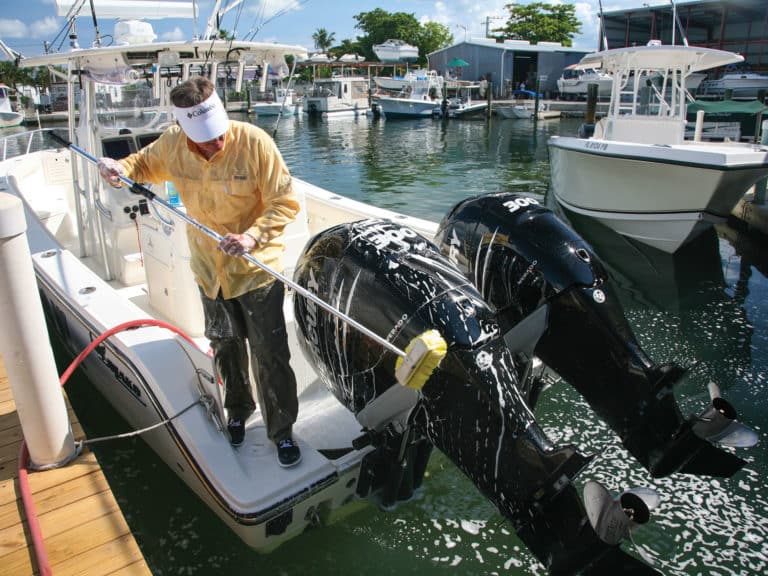Each spring, huge schools of yellowfin tuna swim into the waters surrounding the Bahama Islands, and since it appears the Bahamian government has denied the permit application of the brothers who wanted to purse-seine the tuna, it looks as if this exciting fishery will be around awhile longer.
Knowledgeable captains have countless yellowfin tuna fishing spots in the Bahamas, and since the fish migrate through the islands all summer, you might find them anywhere on a given day. But the fish return to certain places like clockwork each year. These include the Northwest Providence Channel, the deep body of water between Grand Bahama Island to the north and Great Bahama Bank to the south, Tongue of the Ocean east of Andros, the reefs north of Harbour Island at the northern end of Eleuthera, and the pinnacles just north of San Salvador. But any island along the eastern edge of the chain can hold fish at one time or another.
Finding the fish usually isn’t hard – but catching them can be a different matter entirely. Yellowfin spend the vast majority of their time far below the surface. If you’re lucky enough to intercept them on the rare occasion when they rise to feed on the surface, you are way ahead of the game. But what about the other 90 percent of the time, when you know the fish are there but they stay deep? How can you elicit a strike in those circumstances?
We’ve all played the game of chasing schools of tuna around the ocean. They pop up a mile away, so you steer to where you see them only to have them sound and pop up again where you just were. It can be frustrating: Yellowfin behave differently in the Bahamas than they do in places like North Carolina, where in winter they seem neither leader- nor boat-shy. Maybe it’s because of the warmer water, but they can definitely be boat-shy and skittish in the Islands.
After many years of chasing the fish myself, I noticed that certain skippers scored consistently with yellowfin when many of the rest of the fleet did not. I therefore sought out the advice of these pros and have learned several techniques which will maximize your chances on yellowfin in the Bahamas even when other boats seem to have no luck. As with all types of fishing, it’s all about creating your own luck.
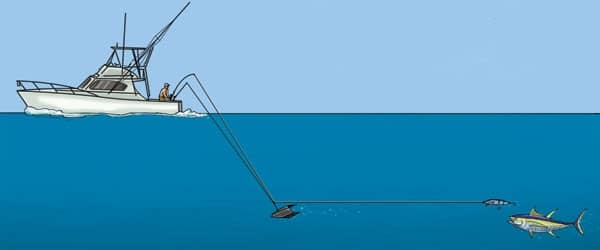
Go Deep
By sending a swimming plug deep beneath the boat with a Z-Wing, you remove the association between boat and lure, and you put the lure directly in the zone where the tuna are feeding most of the time. This combination often proves deadly.
Richard Julylia knows more about subsurface fishing than just about anyone I know. He worked as a sales representative for Cannon Downriggers when I first met him in the mid-1980s, and he had made a name for himself as an expert at catching wahoo off Matanilla Shoal, the western edge of the Little Bahama Bank. He later became a consultant to Kristal Fishing, the builders of quality electric deep-drop reels, and he has become a master at deep-dropping.
But Julylia also likes fishing for yellowfin, and he has refined a technique that has proven deadly in almost all situations. “It’s exciting to troll baits on top when the tuna are up,” Julylia says, “but as we all know, tuna spend most of their time deep. With that in mind, I started to target them with downriggers. Over the years, I have tried many different combinations of baits, downriggers, weights and speeds.
“I prefer to use artificial plugs like a Rapala CD 18 or CD 22, or Yo-Zuri or Braid lures,” he continues. “When you’re using frozen natural baits, they often get damaged without tripping the release. You can use any type of downrigger, but I use a Kristal XL 651 reel loaded with 200-pound braided line and a high-speed Z-Wing.” Julylia doesn’t use weights to keep the lures down, preferring the simplicity of the Z-Wing. “The angle of the line while trolling with the Z-Wing will be about 45 degrees,” he says, “which means that your lure will run at about half the amount of line you have out, so with 100 feet of line out, your lure is down about 50 feet.”
Julylia rigs a Black’s release clip 4 feet above the Z-Wing. “On my 50-pound rod, I let out about 200 feet of line with a CD 22 Rapala at the end,” Julylia says. “I then wrap a No. 64 rubber band four times around the 50-pound line and put both ends of the rubber band in the clip. This allows a clean release without damaging the line. I lower the Z-Wing to about 150 feet, always keeping pressure on the reel as I deploy line. I use only one downrigger at a time, and I troll at about 6 knots. My choice of lure colors are black, white and purple.”
By putting his lure where the fish are swimming, Julylia gets strikes when everyone else comes up empty. And by keeping a sharp eye on his depth sounder, he can mark the schools of fish beneath the boat, keeping the lures at the right depth and passing through them again and again. The fish aren’t as skittish when they’re deep, far from the boat traffic above, and always seem eager to bite.
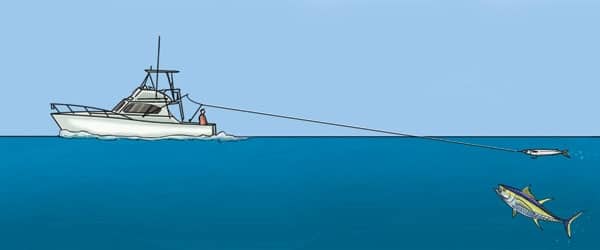
Drop Back
As with the deep-fishing method, dropping your bait back a long way behind the boat fools the tuna into thinking the two aren’t related. But wind fast when the bite comes because sharks love yellowfin too._
On another of my trips, to San Salvador in July, the yellowfin were busting all over the surface above the seamounts north of the island, but every time we approached them, they dove. After three days, we had caught only one small fish. A boat from South Carolina, however, returned each day with a full box, sending me on a fact-finding mission to their corner of the marina.
The captain had the boat rigged with a “greenstick,” one of those giant vertical outriggers you often see in the Northeast. A greenstick allows you to pull baits far behind the boat from a high angle so they work as they should. These guys were catching yellowfin by dropping their baits back – way, way back.
“We put out half a spool on a 50-wide,” the captain told me. “If you think you’ve got it out far enough, go a little farther.” They were pulling naked ballyhoo rigged with a small chin weight on long fluorocarbon leaders, trolling very slowly, maybe 3 knots or so. With the baits 300 yards behind the boat, the tunas disassociated the bait and the boat and ate with abandon. The only trick is to back down like crazy after the bite to keep the sharks from getting them as you wind in all that line.
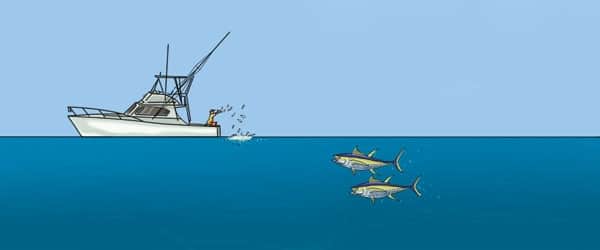
Chum Them Up
Unlike deep fishing or dropping back, chumming is an up-close-and-personal style of tuna fishing – it’s a lot of fun. You can often get the fish to come in very close to the boat, making this method visually exciting as well as productive._
Another option for enticing wary yellowfin involves chumming. Live bait works best but can be difficult to procure in the Bahamas. Cut-up chunks of baitfish work just about as well, and you can bring them with you from home.
When you find yellowfin but have difficulty catching them with conventional methods, go into stealth mode. Shut off your engines and even your generator to drift quietly. Set up a steady flow of chum, live or dead, to attract the fish to the boat. It’s amazing how close you can bring them when the boat isn’t moving or making noise.
Drift a nose-hooked live bait back while tossing freebies. If you lack live bait, bury a circle hook in a chunk and let it drift back with the other chunks, taking care not to put pressure on the hook bait, thereby making it look unnatural. If the tuna are feeding in a specific area, your stream of chum will get their attention almost every time.
Several years ago, we used this method while fishing out of Harbour Island on a reef known as Dutch Bars. Tuna fishing had been slow, with mainly small fish biting on top, a mixed bag of little yellowfins and blackfins. My wife tossed out a live pilchard on a 20-pound spinning rod, expecting a small tuna – she caught two small ones before a third crashed the bait in a huge boil.
The big yellowfin took her to the spool of the reel twice as it went deep, but it finally rose to the surface, where we got a good look at it and realized how big it was. We backed down on the fish for over an hour before sinking the gaff into it. The fish weighed 135 pounds back at the dock, and no one else caught a tuna close to its size all week. Without the combination of stealth and live bait, we wouldn’t have either.
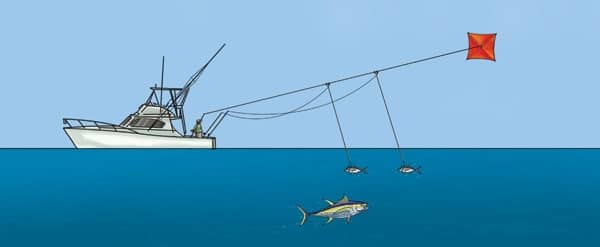
4. Go Airborne
Baits fished from kites often produce when nothing else will. Live baits transmit frantic sounds, which tuna and many other species find irresistible.
The last trick involves kites. As with chumming, stealth helps immensely, but if you fly a kite bait or two from a dead boat in the path of feeding fish, a strike will likely come. Once again, live baits work best, but they aren’t necessary.
Dead flying fish and ballyhoo work well too. Savvy captains have refined their techniques with these baits, pinning the wings of flying fish open with light wire so they look natural while lying on the surface beneath the kite. You can also fly the kite out far from the boat while holding the bait in your hand. When the kite and the release pin are far away, toss the bait overboard and reel fast: The bait skips across the surface and away from the boat like a fleeing fish and often draws a strike.
Kites also work well when you’re doing several kinds of fishing at once. Since yellowfin often feed along reefs, many captains anchor and fish deep for snapper and grouper while deploying a kite in the hopes of intercepting tuna that are feeding up and down the line. Such opportunistic methods work well and maximize your chances of having a successful day.
The Bahamas
What: Yellowfin tuna.
When: April to August.
Where: Here’s a list of Bahamian ports where you’re likely to find schools of yellowfin close by.
Grand Bahama Island
Old Bahama Bay
877-949-4466
www.oldbahamabay.com
Blue Marlin Cove
242-349-4101
www.bluemarlincove.com
Port Lucaya Marina
242-373-9090
www.portlucaya.com
Harbour Island
Valentines Resort
800-848-4073
valentinesresort.com
Harbour Island Marina
800-492-7909
www.harbourislandmarina.com
Tongue of the Ocean
Chub Cay
954-634-7496
www.chubcay.com
Andros Lighthouse Yacht Club
242-368-2305
www.androslighthouse.com
San Salvador
Riding Rock Resort
800-272-1492
www.ridingrock.com








